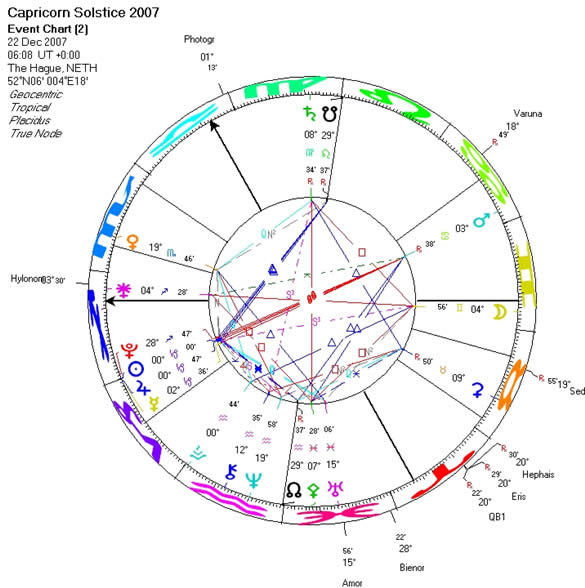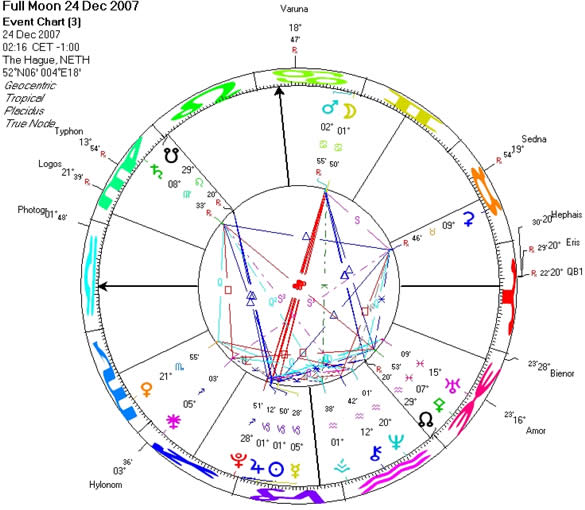
Capricorn solstice -- December 22, 2007, 06:08 UT. Chart by Solar Fire.
SOLSTICES ARE TIMES when the Sun in its apparent annual motion along the ecliptic reaches its northern and southern extremes. Astrology at the time of a solstice or equinox (the midpoints between the solstices) are often used as predictive tools by astrologers.
The Sun reaches its most southern point around Dec. 22 each year. This is when the Sun "stands still" at the first degree of Capricorn, hence the term sol (Sun) stice (still, as in stasis). The Sun is crossing one of the cardinal points (also known as the four directions, which are the first degrees of Aries, Cancer, Libra and Capricorn). The cardinal points are highly sensitive, all directly related to one another. They tend to arrive with the message that the personal is political. Planetary events near these points tend to connect us to the larger events and movements in society around us.
The current solstice chart looks noteworthy, accented by many points collecting around the first degree of Capricorn. There is not just the Sun there, but also Jupiter in the same degree, and Mercury and Pluto very close by, too. Pluto is still near the Galactic Core and the Sun and Mercury passed the point only some days earlier. Jupiter entered Capricorn Wed. night, Dec. 18. Mercury entered Capricorn on Dec. 20, and the exact Sun-Pluto conjunction occurs on Fri., Dec. 21. The quadruple conjunction of these planets suggests that something we will all notice is about to happen, a total rebirth or transformation.
True, this is happening all the time, but some times we notice more than others. The involvement of so many planets in a cardinal sign suggests that some pioneering work is going to arise, something that we all are going to notice; the involvement of Capricorn points to government or a large corporation, and the movement in Pluto into Capricorn talks about a restructuring of some kind in any event. When Chiron reached this point in late 2001, we saw massive corporate restructuring and many scandals were revealed.
Sun-Mercury-Jupiter conjunction also squares the Centaur planet Bienor, "the Strong One," currently in the late degrees of Pisces. Bienor will be arriving in Aries soon enough and will be in a square aspect to Pluto through 2008.
Retrograding Mars in Cancer is also in the aspect structure. It will soon make exact oppositions to Mercury and Jupiter, and then the Sun and finally Pluto. Mars is acting both as a counter-balance in this equation and as a kind of protagonist. But Mars is retrograde in a receptive, emotional sign: it's not likely making its presence known unless provoked, which would not be that difficult.
The Moon in early Gemini squares Saturn, which stationed retrograde in Virgo on Dec. 19. The Moon opposes asteroid Juno, the queen of the gods who was known for her jealousy, and the Centaur planet Hylonome, which has associations with grief, healing of unnecessary grief, and mass appeal.
Mercury, the planet of all communication, forms a very close novile (40 degrees, division of the circle by 9) to Chiron, who in mythology was a great teacher. The novile series of aspects are related to trines and sextiles, and they are said to be related to the Nine Muses, who offer their inspiration in the arts and sciences.
Venus in Scorpio squares Neptune and opposes Sedna, the goddess of the frozen waters. In this T-square we have two watery planets, Neptune and Sedna, and two goddesses of abundance, Venus and Sedna, aspecting each other. Venus is reminding us to keep our hearts open and to be compassionate, and in Scorpio on any theme associated with Venus: love, eroticism, or materialism. Square Neptune, we have the potential for unrealistic feelings and wishy-washy values slipping in. Those would be the presence of values we don't really hold, or some form of self-deception.
The theme of universal love is repeated in the conjunction of asteroid Amor and Uranus in Pisces. The North Node of the Moon has recently entered Aquarius, the sign of universal brotherhood. Venus is also trining Varuna, "the great equalizer," another water god.
In one of the cardinal points in the early degrees of Libra we have asteroid Photographica, which deals with all things photographic and photogenic, often manifesting in a literal way.
In Aries asteroid Hephaistos is in tight conjunction with Eris and 1992 QB1. In Greek mythology Hephaistos was the god of technology, blacksmiths, craftsmen, artisans, sculptors, metals and metallurgy, and fire. His Roman equivalent was Vulcan, husband of Venus.
What exactly this chart is heralding remains to be seen.

Full Moon in Cancer -- December 24, 2007, 01:16 UT. Chart by Solar Fire.
The Full Moon in Cancer occurs in the early hours of Christmas Eve. Now also the Moon is occupying one of the cardinal points. The chart is having a strong Aries Point flavor.
The Moon has entered Cancer a couple of hours before midnight (UT) and is conjunct Mars. Not much else has changed in the two days since the solstice. In Virgo two binary Kuiper belt objects have stationed retrograde meanwhile, Typhon and Logos.
CREDITS: Associate Editor: Priya Kale. Webmaster: Anatoly Ryzhenko. Horoscope Editor: Jessica Keet. Associate Photo Editor: Sharon Bellenger. Business Manager: Chelsea Bottinelli. Published by Planet Waves, Inc., a Washington State corporation, all rights reserved.
|